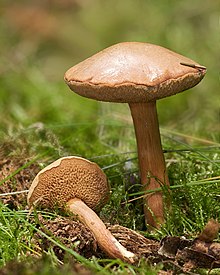|
Chalciporus
Chalciporus is a genus of fungi in the family Boletaceae (suborder Boletineae).[1] There are approximately 25 species in the genus.[2] French mycologist Frédéric Bataille erected the genus in 1908, though it did not gain general acceptance for several decades and was often classified as a section (Piperati) of the genus Suillus or related to the genus Pulveroboletus. The type species is Chalciporus piperatus.[3] Rolf Singer resurrected the genus in 1973, separating the species from the genus Suillus on the basis of distinct pigments.[4] The name is derived from the Ancient Greek khalkos "copper",[5] and translates as "copper pores".[6] The genus Chalciporus, together with the genus Buchwaldoboletus form a group of fungi that is an early offshoot in the Boletaceae. Many members of the group appear to be parasitic.[7] Wu and Yang proposed that this clade be called the subfamily Chalciporoideae.[8] The genus Rubinoboletus was merged into this genus based on their morphological similarity,[9] and subsequent genetic analysis—mainly due to Rubinoboletus (now Chalciporus) rubinus being nested within Chalciporus.[3][8] Members of the genus Chalciporus have boletoid fruit bodies with pores that are various shades of red to pink, stipes lacking in reticulations, yellow mycelium and smooth oval spores.[3] Two species, C. chontae and C. radiatus, have pores that are arranged in furrows that radiate out from the top of the stipe under the cap and resemble gills.[3] C. piperatus and C. piperatoides are peppery-tasting, the former is edible while the latter is unknown. C. rubinellus and C. pseudorubinellus are milder-tasting and edible.[6] Species
References
|
||||||||||||||||||||||||||||||
